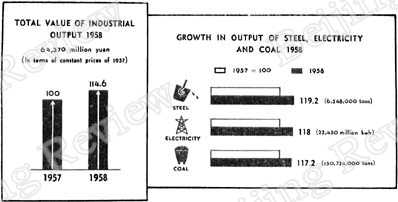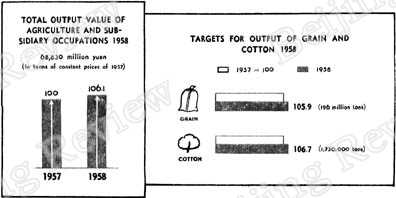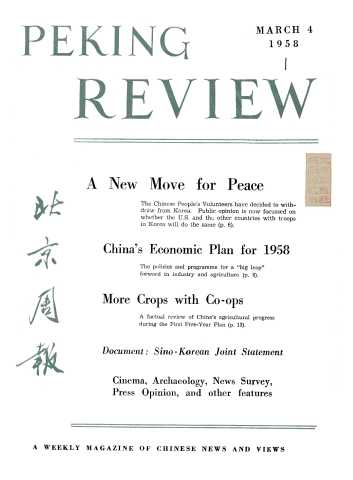All the signs point to a big spurt in China's national economy in 1958. The First Five-Year Plan has been successfully fulfilled; the rectification campaign to find better ways of doing things is booming along. This is the background for the wave of popular enthusiasm to get ahead with building socialism, to bring about a "leap" in the national output.
The following excerpts from the report on the draft national economic plan for 1958, given by Po I-po at the National People's Congress on February 3, shows the scale of advance envisaged.
1958 is the first year of China's Second Five-Year Plan. And our major tasks in developing the national economy this year are these: We must work energetically to promote the current upsurge in agricultural production; we must vigorously develop heavy industry, chiefly to raise the output of fuel, electric power, raw materials, chemical fertilizers, heavy machinery, power-driven machinery for agricultural use and electrical power equipment; increase investments to the limit of our material and financial resources in capital construction, mainly for productive enterprises; work hard to increase the output of consumer goods, continue our efforts to keep market prices stable and suitably improve the living standards of the people on the basis of expanded reproduction; and energetically promote culture, education and public health.
Capital Construction
The total investment in capital construction in 1958 is tentatively fixed at 14,577 million yuan, 17.8 per cent over the estimated figure for 1957. This amount does not include capital investments made by agricultural producers' co-operatives, handicraft producers' co-operatives and other kinds of co-operatives. The large-scale campaign to build irrigation works which has been spreading in the countryside since last winter is expected to grow bigger in 1958. This means, in fact, a substantial investment in capital construction. So the speed and scale of the capital construction in 1958 will far exceed that of any previous year.
In allocating investment funds, more money will be spent on agriculture, particularly on water conservancy projects, and also on various branches of heavy industry, particularly fuel, electric power, metallurgy, chemical industry and other branches serving agriculture. At the same time, to bring things into line with the improvements made in the system of administration, we will increase investments for construction in the various provinces to promote local industries serving the needs of the rural areas and accelerate the economic development of areas inhabited by minority nationalities.
In 1958, work on 1,185 "above-norm" or high-investment projects[注释1] will be continued or begun. They are classified as follows:
| Industrial projects | 716 |
| Agricultural, forestry and water conservancy projects | 185 |
| Communications and transport projects | 106 |
| Trade department projects | 47 |
| Cultural, educational and public health projects | 60 |
| Urban public utilities projects | 47 |
| Other construction projects | 24 |
| Total | 1,185 |
Of the industrial projects, 567 will be under the central government while 149 will be administered by local authorities. One hundred and eighty-eight of these can be completed within the year. In other words, every 46 hours on an average, a new, big factory or mine will be put into operation.
Metallurgical Industry There are 71 projects, of which 14 will be completed within the year. With the completion of these projects, the metallurgical industry this year will add to its annual capacity 1,880,000 tons of pig iron, 1,166,000 tons of steel, 762,000 tons of steel products, etc.
In expanding the metallurgical industry, it is the government's policy to promote the development of small and medium size local metallurgical works in co-ordination with the construction of large-scale metallurgical plants. Fourteen metallurgical projects under local administration will be started or expanded in 1958.
Electric Power Industry Of the 119 projects, 100 are power stations - 76 being thermal and 24, hydro-electric. Thirty-five of these projects can be completed within the year to increase generating capacity by more than 900,000 kilowatts, producing more than 4,500 million kwh per year. In developing the power industry, our long-term policy is to put the main emphasis on the building of hydro-electric stations with thermal-power stations in second place.
Starting this year, we should vigorously push ahead preparatory work in the prospecting, surveying and planning of the Yangtse River Basin for the Yangtse River Gorge water-conservancy and power-generation project.
Fuel Industry There are 232 projects. Among the 32 projects under local administration, 31 are coal mines, and the planned capacity of the new mines is 7,010,000 tons a year. Fifty-two of these projects can be completed this year, to increase the output of coal by 24,420,000 tons, and the capacity for refining synthetic petroleum by more than 20,000 tons.

By putting greater efforts into the construction of small and medium size local coal mines, more coal can be provided for local domestic users.
To end the backward state of our petroleum industry, the central authorities have laid down the policy of simultaneously developing the production of natural and synthetic petroleum.
Machine-Building Industry There are 79 projects. Twenty-seven of these will be completed this year to enable us to produce annually another 30,000 tons of metallurgical machinery, 27,000 tons of mining machinery, 20,000 tons of heavy machine-tools and over 10 million more ball-bearings.
Chemical Industry There are 42 projects. Among these, 17 are chemical fertilizer factories. Four of these projects will be completed this year with a resulting increase in productive capacity of 47,000 tons of synthetic ammonia, 548,000 tons of phosphate fertilizer, and 300,000 tons of phosphate mineral powder.
Light Industry There are 39 projects under the central government and 53 under local administration - a total of 92. These include 15 cotton mills and cotton fabric dyeing factories, 23 paper mills, 12 sugar refineries and 10 salt refineries. Thirty-one of these projects will be completed this year. They will increase our productive capacity by 387,000 bales of cotton yarn, 110 million metres of cotton cloth, 204,000 tons of machine-made paper, 345,000 tons of sugar and 650,000 tons of unrefined salt.
Agriculture As regards capital construction in agriculture, the state in 1958 is undertaking to build 73 above-norm water conservancy projects. Work is continuing on 38 of these, while the remaining 35 are new projects to be started this year. Twenty-one of these projects will be completed this year.
The state will invest 235 million yuan in the reclamation of wastelands this year, and the Ministry of State Farms and Land Reclamation will reclaim 7 million mou. If we add to this the land to be reclaimed by state farms under local authorities, by the local people and new settlers, the total area of land reclaimed in 1958 will be 17,735,000 mou.
In 1958, the state will invest in the afforestation of land totalling 4,283,000 mou. At the same time, there will be a further growth of the mass movement for tree-planting and afforestation.
In 1958, it is planned to supply the agricultural machinery tractor stations with an additional 1,457 tractors. Many farm co-ops are very keen on the technical reconstruction of agriculture; they have larger funds available, so they will purchase more new-type farm implements and irrigation equipment.
Transport The state will invest 2,200 million yuan in 1958 in the field of communications and transport. About two-thirds of this sum will be used for railway construction.
In railway construction, it is planned to lay about 1,500 kilometres of track, including both new tracks and the double tracking of existing lines. Most important are the completion of the line between Paotow and Lanchow to link up north-west China with the Inner Mongolian Autonomous Region, and a 300-kilometre section to carry the Lanchow-Sinkiang Railway up to Hami. According to plan the length of railway to be formally opened to traffic in 1958 will be 2,234 kilometres.
The Ministry of Communications is going to build eleven highways, mainly roads leading to regions inhabited by the minority nationalities in China's south-west.
In water transport, the Ministry of Communications will construct the docks at Shanghai, Tientsin, Chungking, Chankiang, Paso on Hainan Island, and Yuhsikow in Anhwei Province, and increase shipping tonnage by more than 78,000 tons.
Industrial Production
The total value of industrial output in 1958 is set at 64,370 million yuan (in terms of constant prices of 1957), which is 14.6 per cent greater than the estimated figure in 1957. The total value of handicraft output is set at 10,370 million yuan (in terms of constant prices of 1957).
In the total value of industrial and handicraft output, means of production account for 35,660 million yuan, 18.8 per cent more than last year, and consumer goods for 39,080 million yuan, 9.7 per cent more than last year. The output of means of production will continue to lead the Way but the output of consumer goods will increase at a much more rapid rate than in 1957.
In order to meet the needs of the development of the national economy as fully as possible, energetic efforts will be made in 1958 to push up production of fuel, electricity and raw materials. For example, the output of steel is set at 6,248,000 tons, or 19.2 per cent over 1957; electricity at 22,450 million kwh, an increase of 18 per cent; and coal at 150,724,000 tons, an increase of 17.2 per cent.
The year 1958 will witness a rapid expansion of the machine-building industry. This includes an increase of more than 50 per cent in output of power-generating sets, electric motors, equipment for the production of nitrogenous fertilizer, motor trucks, steam-driven locomotives, etc. In 1958 about 60 per cent of the complete sets of equipment for the 156 major projects designed with the help of the Soviet Union will be made in China. In 1957 the figure was about 42 per cent.
In 1958 there will be an even more rapid increase in the output of agricultural machinery. For instance, the output of drainage and irrigation equipment will be more than three times what it was in 1957. This year the peasants will get another half million horsepower for irrigation and drainage, approximately equivalent to the total horsepower of existing pumps in the villages.
To cope with the urgent needs of agricultural development, there will be a notable increase in the output of chemical fertilizers in 1958. The plan envisages the production of 906,000 tons of nitrogenous fertilizer and 196,000 tons of phosphate, increases of 33.7 per cent and 63.9 per cent respectively compared with 1957. There will also be a certain increase in the output of insecticides.
The 1958 plan for industrial production has not only provided for increases in output, but also paid attention to the introduction of more new types and varieties of products.
It lays down that the ministries of the central government alone should begin trial manufacture of 372 kinds of new, major products this year, including the following: cold-rolled silicon steel sheets, heat-resistant stainless steel for the aircraft industry, high-pressure air-compressors and synthetic chambers for the nitrogenous fertilizer industry, complete sets of 50,000-kilowatt thermal power-generating equipment, complete sets of 72,500-kilowatt hydro-electric power-generating equipment, 220,000-volt high-tension transformers, 1,513-cubic-metre blast furnaces, 1,150-millimetre rolling mills, 54-horsepower caterpillar tractors, ocean-going cargo ships of over 13,000 tons deadweight, television transmitters and receivers, synthetic fibres, etc.

Agricultural Output
In the light of the new upsurge in agricultural production, the total output value of agriculture and subsidiary occupations this year is estimated at 68,830 million yuan (in terms of constant prices of 1957), or 6.1 per cent more than in 1957. This rate of increase far surpasses the average rate of increase envisaged in the First Five-Year Plan. Take the output of grain and cotton for instance. The target for output of grain in 1958 is set at 392,000 million catties, which is 5.9 per cent more than last year. The target for cotton is 35 million tan, which is 6.7 per cent more than last year.
This year, the total acreage under cultivation is planned to reach 1,692,450,000 mou, or 10,250,000 mow more than last year. The total sown area[注释2] will be 2,414,800,000 mou, an increase of 68,900,000 mou. The total irrigated area will be more than 600 million mou. The area sown to food crops in 1958 will be 1,839,260,000 mou, or 31,750,000 mou more than last year, while cotton fields will occupy an area of 90,300,000 mou, or 4,120,000 mou more than last year.
In 1958 we should afforest 65,060,000 mou of land and replenish and grow saplings on another 2,190,000 mou where trees have been felled.
People's Welfare
The total number of workers and staff covered by the state plan will reach 24,392,000 in 1958, that is, 419,000 more than last year. The total wage bill is set at 15,800 million yuan, or 550 million yuan more than last year.
Commodities to be supplied this year are valued at 50,000 million yuan, 6.5 per cent more than last year. Pork will be up by some 620 million catties, cotton piece goods by about 5,780,000 bolts, coal by about 7,700,000 tons.
In accordance with the above arrangements concerning employment and wages social purchasing power in 1958 is estimated at around 49,400 million yuan. The amount of commodities which can be supplied is in excess of social purchasing power. This will not only ensure stability of the market and commodity prices, but will also permit our commercial departments to hold a certain amount of goods in reserve.
In foreign trade, the total amount of import and export trade in 1958 is set at 11,000 million yuan, an increase of 8.6 per cent over last year.
Favourable Conditions
We should work hard to bring about a new forward leap in the development of our national economy in 1958.
Is it possible to do so? Our answer is "Yes!" A favourable situation has been created by the nation-wide rectification campaign, the anti-rightist struggle and the socialist education campaign. This means that our political system has been further consolidated; unity among the people has been further strengthened; the socialist consciousness of the entire people further enhanced. There can be no doubt that the unprecedented enthusiasm for socialism which has arisen out of the rectification campaign, will exert a far-reaching influence on the development of our national economy.
The achievements of the First Five-Year Plan are an additional advantage. Many new and hitherto nonexistent industrial departments have been established while our industrial productive capacity has grown rapidly. Except for some heavy and precision equipment which we cannot yet manufacture, we have been able to use many types of home made equipment to build most of the heavy industrial enterprises and nearly all the light industrial enterprises that we need, and also to equip our agriculture and transport step by step and strengthen our national defence.
Improvements in the system of administration have made it possible for the local authorities to show greater initiative in utilizing local manpower and materials, financial and natural resources for the development of agriculture and industry. Apart from that, by putting the local authorities in charge of the many undertakings that they can run well themselves, the central authorities will be able to concentrate their efforts to a still greater extent on key projects, and thereby better promote the development of the national economy as a whole.
Special mention must be made here of the favourable international situation. The successful launching of the two artificial satellites by the Soviet Union and the conference of the Communist and Workers' Parties of over 60 countries in Moscow in 1957 marked a new turning-point in the balance of political forces in the world. Since then, the international situation has developed more and more favourably for the camp of peace, democracy and socialism headed by the great Soviet Union. The fraternal solidarity of the socialist countries has been further strengthened, and so has that between China and the Soviet Union. The overfulfilment of our First Five-Year Plan is closely connected with the enormous assistance extended by the Soviet Union and other fraternal countries. During the Second Five-Year Plan period, the Soviet Union and other fraternal countries will continue to give us generous help to enable us to advance still more speedily to the great goal of socialism.
We have now entered the second month of 1958. Several things-the amount the state is prepared to invest in capital construction, the great upsurge in agricultural and industrial production-show that the trend towards a new forward leap in the national economy this year is beginning to manifest itself. The people of the entire country should seek by every means to promote this new leap forward.
[注释]
Vice-Premier and Chairman of the National Economic Commission
[注释1]
The norm of investment in capital construction for heavy industry ranges between five to ten million yuan and that for light industry, between three to five million yuan.
[注释2]
Large areas are cropped twice or more each year.


 Copy Reference
Copy Reference